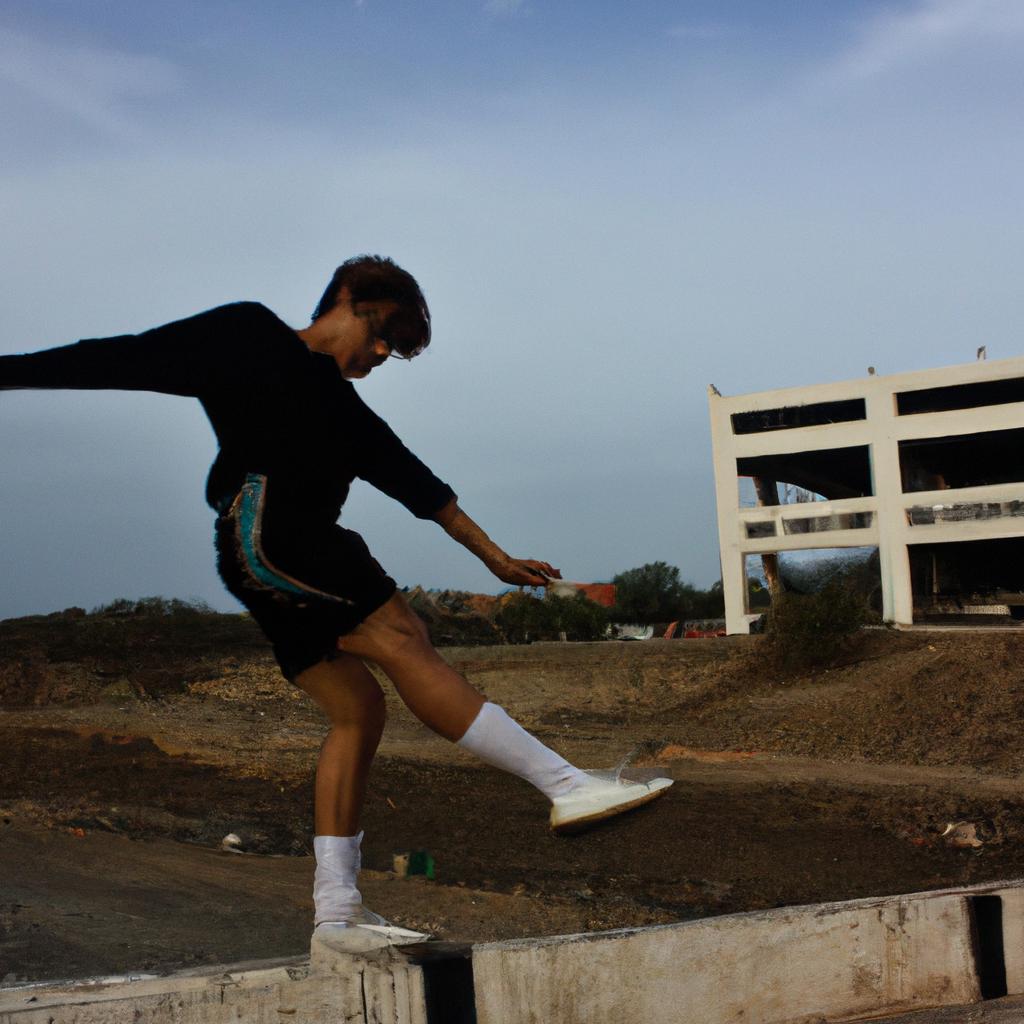The Stanislavski Method, also known as the system or method acting, is a widely recognized approach to actor training and character development in the field of arts and movies. This technique, developed by Russian theatre practitioner Konstantin Stanislavski in the late 19th century, has been influential in shaping modern acting practices around the world. One example that highlights the effectiveness of this method is Marlon Brando’s performance in “A Streetcar Named Desire.” Through his meticulous use of emotional memory and physical actions, Brando brought depth and authenticity to his portrayal of Stanley Kowalski, leaving an indelible mark on both stage and screen.
Stanislavski’s approach revolutionized traditional theatrical conventions by emphasizing psychological realism over external mannerisms. By delving into an actor’s inner life and motivations, he believed performers could achieve a more truthful representation of human behavior. The method involves extensive research into a character’s background, objectives, and circumstances to better understand their thoughts and emotions. Additionally, it encourages actors to tap into their own personal experiences as resources for creating authentic performances. Through these techniques, Stanislavski aimed to bridge the gap between reality and fiction on stage and screen, enabling actors to connect with audiences on a deeper and more profound level.
Stanislavski’s Early Life and Influences
Stanislavski’s Early Life and Influences
One of the most influential figures in the world of acting, Konstantin Stanislavski revolutionized the field with his innovative approach to performance known as the Stanislavski Method. Born on January 17, 1863, in Moscow, Russia, Stanislavski was exposed to theater at an early age due to his family’s involvement in the arts. His father owned a successful manufacturing business but had a deep love for amateur theater. This familial connection ignited young Konstantin’s passion for acting and laid the foundation for his future endeavors.
Growing up amidst a society undergoing significant cultural changes, Stanislavski found himself influenced by various artistic movements that emerged during that time. The Realist movement, which emphasized portraying life truthfully on stage, resonated strongly with him. Additionally, he drew inspiration from playwrights like Anton Chekhov and Henrik Ibsen who explored complex psychological themes through their works. These influences shaped Stanislavski’s belief that actors should delve into realistic portrayals of characters by delving into their motivations and emotions.
To better understand human behavior and develop more authentic performances, Stanislavski conducted extensive research and experimentation. He observed people in everyday situations and studied psychology to gain insights into how different individuals express themselves emotionally. Drawing upon this knowledge, he developed a series of techniques aimed at creating believable performances rooted in genuine emotional experiences.
This emphasis on realism became one of the core principles of the Stanislavski Method. To evoke an emotional response from audiences while keeping performances grounded in authenticity, practitioners are encouraged to:
- Immerse themselves fully in their character’s circumstances.
- Develop a thorough understanding of their character’s background and history.
- Connect emotionally with the material they are performing.
- Employ physical actions and gestures that reflect their character’s inner thoughts and intentions.
Furthermore, Stanislavski introduced the concept of “the magic if,” which encourages actors to imagine themselves in their character’s situation and consider how they would react. This technique fosters a deep empathy and understanding between actor and character, resulting in more genuine performances.
| Techniques Developed by Stanislavski | Purpose |
|---|---|
| Emotional Memory | Accessing past emotions to enhance performance |
| Sense Memory | Using senses to recall emotional experiences |
| Subtext | Unspoken thoughts or motives beneath dialogue |
| The Method of Physical Actions | Aligning physical movements with internal motivations |
With the foundation laid through his early life experiences and influences, Stanislavski embarked on a journey that led him to develop what is now known as the Stanislavski Method. In the subsequent section, we will explore the birth of this revolutionary approach to acting and its impact on the arts and movies.
The Birth of the Stanislavski Method
In exploring the development of the renowned Stanislavski Method, it is essential to delve into Konstantin Stanislavski’s early life and the influences that shaped his approach to acting. One example that highlights these formative years is a young Stanislavski attending performances at the Moscow Theatre, where he witnessed powerful portrayals by actors who moved audiences with their authentic emotions and realistic characterizations.
Stanislavski’s immersion in the theater world prompted him to question traditional acting techniques prevalent during his time. He sought to develop a more comprehensive method that would enable actors to achieve emotional truthfulness on stage consistently. To accomplish this, he drew inspiration from various sources and incorporated them into his teachings:
- Psychology: Recognizing the importance of understanding human behavior, Stanislavski explored psychological concepts such as motivation, empathy, and inner thoughts.
- Physicality: Emphasizing the connection between mind and body, he emphasized physical exercises aimed at enhancing an actor’s awareness of movement and posture.
- Ensemble work: Acknowledging the significance of collaboration within a theatrical production, Stanislavski promoted ensemble training exercises to foster unity among cast members.
- Realism: Rejecting melodramatic conventions popular at that time, he advocated for naturalistic performances rooted in believable actions and reactions.
To provide a visual representation of these key influences on Stanislavski Method’s development, consider the following table:
| Influence | Description |
|---|---|
| Psychology | Exploration of human behavior through deep analysis |
| Physicality | Integration of body movements for heightened expressiveness |
| Ensemble | Collaboration among actors for cohesive performances |
| Realism | Prioritization of authenticity through believability |
The birth of the Stanislavski Method was not merely a product of one individual’s ideas but rather a culmination of influences and experiences. By combining psychological insights, physicality, ensemble work, and realism, Stanislavski revolutionized acting techniques. This paved the way for further exploration into the profound impact of emotional memory on an actor’s performance—a topic that will be discussed in the subsequent section.
Building upon his early influences, Stanislavski delved deeper into the role of emotional memory within his Method, unlocking new dimensions of authenticity and intensity on stage.
The Importance of Emotional Memory
The Birth of the Stanislavski Method: A Revolutionary Approach to Acting
One example that illustrates the transformative power of the Stanislavski Method is the case study of Marianne, a young actress struggling to emotionally connect with her characters. Before learning about this method, Marianne found it challenging to portray authentic emotions on stage and often felt disconnected from her performances. However, after immersing herself in the principles of the Stanislavski Method, she discovered a newfound ability to tap into her emotional memory and fully embody her characters.
To better understand why the Stanislavski Method has such a profound impact on actors like Marianne, it is essential to explore its key components:
-
Emotional Memory: Perhaps one of the most crucial aspects of this method is its emphasis on using personal experiences and memories as tools for developing genuine emotions during performances. By drawing upon their own past emotional encounters, actors can create vivid and authentic portrayals.
-
Given Circumstances: Another fundamental concept within this technique revolves around understanding and utilizing the circumstances surrounding a character’s life. Actors delve deep into research, exploring every detail about their role’s background, relationships, environment, and social context. This thorough analysis helps them develop a comprehensive understanding of their character’s motivations and behaviors.
-
Subtext: The Stanislavski Method also focuses heavily on subtext—the unspoken thoughts or feelings beneath a character’s dialogue. It encourages actors to uncover hidden meanings behind lines by analyzing textual clues and infusing their delivery with subtlety and nuance.
-
Active Analysis: Lastly, active analysis involves breaking down scenes into beats or units that allow actors to identify shifts in objectives or intentions throughout a performance. By examining each beat meticulously, performers gain insight into how their character evolves over time, creating dynamic and engaging portrayals.
| Key Components | Description |
|---|---|
| Emotional Memory | Drawing upon personal experiences to evoke genuine emotions in performances. |
| Given Circumstances | Thoroughly researching and understanding a character’s background, relationships, and environment to inform their portrayal. |
| Subtext | Uncovering hidden meanings beneath dialogue, infusing delivery with subtlety and nuance. |
| Active Analysis | Breaking down scenes into beats or units to identify shifts in objectives and create dynamic portrayals. |
Through the Stanislavski Method’s emphasis on emotional memory, given circumstances, subtext, and active analysis, actors are empowered to transcend mere imitation and tap into profound truths within themselves.
Transitioning seamlessly from this exploration of the method’s birth and components, we now turn our attention to the role of objectives and super-objectives in shaping an actor’s performance. By delving into these aspects further, we can uncover how they contribute to creating compelling characters that captivate audiences through their authenticity and depth.
The Role of Objectives and Super-Objectives
Having explored the significance of emotional memory in acting, it is now essential to delve into another crucial aspect of the Stanislavski Method – the role of objectives and super-objectives. By understanding how actors utilize these techniques to shape their performances, we can gain insight into the intricate process that brings characters to life on stage or screen.
One example where objectives play a pivotal role is seen in Tennessee Williams’ iconic play “A Streetcar Named Desire.” In this production, Stella Kowalski’s objective may be stated as “to maintain her love for her husband while navigating a tumultuous relationship with her sister.” This overarching goal drives Stella’s actions throughout the narrative, influencing her choices, emotions, and interactions with other characters. It allows the actor portraying Stella to anchor their performance around this central motivation, creating depth and authenticity.
To better comprehend how objectives function within the Stanislavski Method, consider the following key points:
- Anchoring character motivations: Objectives serve as an anchor point for actors to understand and embody their characters fully. They provide clarity regarding what drives a character’s behavior and decisions within a given scene or overall storyline.
- Shaping relationships: Objectives also contribute significantly to shaping relationships between characters. Each individual’s intentions are influenced by their own goals, resulting in conflict, collaboration, or ambivalence depending on whether those objectives align or clash.
- Evoking emotion: An actor’s objective not only influences their outward actions but also taps into their internal emotional landscape. By focusing on achieving specific objectives, performers can access genuine emotions that resonate with both themselves and the audience.
The utilization of objectives in acting is further enhanced by the concept of super-objectives. A super-objective refers to a character’s broader, long-term goal that spans the entire narrative. It provides a guiding force for an actor’s portrayal, ensuring consistency and coherence throughout various scenes or acts.
Incorporating both objectives and super-objectives into their performances allows actors to establish multi-dimensional characters with depth, complexity, and relatability. By understanding the motivations driving their characters’ actions, performers can create authentic portrayals that captivate audiences through emotional resonance and compelling storytelling.
Understanding how objectives and super-objectives shape actors’ performances is essential when exploring the Stanislavski Method. This knowledge forms a solid foundation for delving into another crucial aspect of this technique – the use of subtext.
The Use of Subtext in Stanislavski Method
Continuing from our exploration of objectives and super-objectives in the Stanislavski Method, another crucial element that actors employ to deepen their performances is subtext. Subtext refers to the underlying thoughts, motivations, and emotions that are not explicitly stated in the script but are conveyed through subtle cues such as body language, tone of voice, and facial expressions. This technique allows actors to bring depth and complexity to their characters by revealing their innermost desires and conflicts.
To illustrate the significance of subtext, let us consider a hypothetical case study involving an actor preparing for a dramatic monologue. In this scene, the character appears calm on the surface while delivering a seemingly innocuous speech about everyday life. However, beneath this composed exterior lies a deep sense of sorrow resulting from past trauma. By utilizing subtext effectively, the actor can communicate this hidden pain without directly stating it, creating a more nuanced portrayal that resonates with audiences.
The use of subtext in acting offers several advantages:
- It enhances believability: By incorporating unspoken thoughts and feelings into their performances, actors create a more realistic portrayal of human behavior.
- It adds depth and complexity: Subtext allows characters to convey multiple layers of emotion simultaneously, making them more relatable and intriguing.
- It fosters emotional engagement: When audiences decipher subtextual cues, they become active participants in understanding the characters’ inner workings.
- It encourages interpretation: The use of subtext invites different interpretations from viewers based on their own experiences and perspectives.
Table: Examples of Subtextual Cues
| Cue | Interpretation |
|---|---|
| Averted gaze | Evading truth or hiding true intentions |
| Tightly clenched fists | Suppressed anger or frustration |
| Forced smile | Hiding sadness or discomfort |
| Trembling voice | Nervousness or inner turmoil |
In conclusion, the Stanislavski Method places great emphasis on the use of subtext as a means to convey hidden emotions and thoughts. By incorporating this technique into their performances, actors can create more nuanced and compelling characters that resonate with audiences on a deeper level. In the subsequent section, we will examine Stanislavski’s legacy in modern acting, highlighting how his techniques continue to shape and influence the craft today.
Stanislavski’s Legacy in Modern Acting
Building upon the exploration of subtext within the Stanislavski Method, we now delve into its profound impact on modern acting practices. By revolutionizing the way actors approach their craft, Constantin Stanislavski has left an indelible mark on the world of performing arts and cinema.
Section:
One example that showcases the enduring influence of Stanislavski’s method is evident in Robert De Niro’s portrayal of Travis Bickle in Martin Scorsese’s film “Taxi Driver” (1976). Through meticulous preparation and a deep understanding of his character’s inner life, De Niro infused Bickle with layers of complexity rarely seen before. His ability to convey emotions beneath the surface through subtle gestures and expressions made for a compelling performance that resonated with audiences worldwide.
The impact of the Stanislavski Method can be summarized through several key points:
- Emotional truthfulness: One fundamental aspect emphasized by this technique is the pursuit of emotional authenticity. Actors are encouraged to tap into their own experiences and memories, allowing genuine feelings to emerge naturally during their performances.
- Psychological realism: In line with delving into one’s emotions, actors using this method strive to understand their characters’ psychological motivations. By exploring the intricacies of human behavior, they bring depth and believability to their portrayals.
- Ensemble collaboration: The Stanislavski Method also promotes a collaborative environment among actors. This fosters trust between performers as they work together towards creating a cohesive and harmonious production.
- Physicality and vocal expression: Another vital element within this approach is recognizing how physicality and vocal expression contribute to characterization. Actors learn techniques to control body language, voice modulation, and breathing, enabling them to communicate effectively beyond mere dialogue.
The enduring legacy of the Stanislavski Method is evident in how it has shaped contemporary acting practices. To further illustrate its impact, consider the following table:
| Actors influenced by Stanislavski’s Method | Notable Contributions |
|---|---|
| Marlon Brando | Naturalistic performances that revolutionized film acting |
| Meryl Streep | Immersive characterizations showcasing emotional depth |
| Al Pacino | Intense portrayals driven by psychological realism |
| Cate Blanchett | Versatility and transformative performances |
This table serves as a testament to the lasting influence of the method on some of the most celebrated actors of our time. By challenging traditional approaches and emphasizing emotional truthfulness, Constantin Stanislavski paved the way for a new era in acting technique.
Incorporating these principles into their craft allows actors to connect with audiences on a profound level, creating memorable performances that stand the test of time. The ongoing relevance and widespread adoption of the Stanislavski Method highlight its significance within both theatrical productions and cinematic masterpieces alike.




